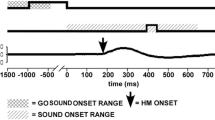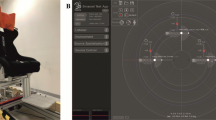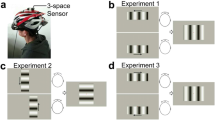Abstract
When a person moves through the world, the associated visual displacement of the environment in the opposite direction is not usually seen as external movement but rather as a changing view of a stable world. We measured the amount of visual motion that can be tolerated as compatible with the perception of moving within a stable world during active, sinusoidal, translational and rotational head movement. Head movements were monitored by means of a low-latency, mechanical head tracker and the information was used to update a helmet-mounted visual display. A variable gain was introduced between the head tracker and the display. Ten subjects adjusted this gain until the visual display appeared stable during sinusoidal yaw, pitch and roll head rotations and naso-occipital, inter-aural and dorso-ventral translations at 0.5 Hz. Each head movement was tested with movement either orthogonal to or parallel with gravity. A wide spread of gains was accepted as stable (0.8 to 1.4 for rotation and 1.1 to 1.8 for translation). The gain most likely to be perceived as stable was greater than that required by the geometry (1.2 for rotation; 1.4 for translation). For rotational motion, the mean gains were the same for all axes. For translation there was no effect of whether the movement was inter-aural (mean gain 1.6) or dorso-ventral (mean gain 1.5) and no effect of the relative orientation of the translation direction relative to gravity. However translation in the naso-occipital direction was associated with more closely veridical settings (mean gain 1.1) and narrower standard deviations than in other directions. These findings are discussed in terms of visual and non-visual contributions to the perception of an earth-stable environment during active head movement.









Similar content being viewed by others
References
Allison RS, Harris LR, Jenkin MR, Jasiobedzka U, Zacher JE (2001) Tolerance of temporal delay in virtual environments. IEEE Int Conf Virtual Reality 3:247–254
Allison RS, Howard IP, Zacher JE (1999) Effect of field size, head motion, and rotational velocity on roll vection and illusory self-tilt in a tumbling room. Perception 28:299–306
Angelaki DE (1992) Detection of rotating gravity signals. Biol Cybern 67:523–533
Aubert H (1886) Die Bewegungsempfindung. Pflugers Archiv Eur J Physiol 39:347–370
Benson AJ (1982) The vestibular sensory system. In: Barlow HB, Mollon JD (ed) The senses. Cambridge University Press, Cambridge, pp 333–368
Blouin J, Amade N, Vercher J-L, Gauthier GM (1999) Opposing resistance to the head movement does not affect space perception during head rotations. In: Becker W, Deubel H, Mergner T (ed) Current oculomotor research. Kluwer Academic/Plenum, New York, pp 193–201
Bridgeman B (1999) Neither strong nor weak space constancy is coded in straite cortex. Psychol Res 62:261–265
Busettini C, Masson GS, Miles FA (1997) Radial optic flow induces vergence eye-movements with ultra-short latencies. Nature 390:512–515
Choudhury BP, Crossley AD (1981) Slow-movement sensitivity in the human field of vision. Physiol Behav 26:125–128
Darlot C, Denise P, Cohen B, Droulez J, Berthoz A (1988) Eye movements induced by off-vertical axis rotation (OVAR) at small angles of tilt. Exp Brain Res 73:91–105
Denise P, Berthoz A, Droulez J, Cohen B, Darlot C (1988) Motion perceptions induced by off-vertical axis rotation (OVAR) at small angles of Tilt Exp Brain Res 73:106–114
Foley JM, Held R (1972) Visually directed pointing as a function of target distance, direction, and available cues. Percept Psychophys 12:263–268
Golding JF, Benson AJ (1993) Perceptual scaling of whole-body low frequency linear oscillatory motion. Aviat Space Environ Med 64:636–640
Graybiel A, Hupp ED (1946) The oculogyral illusion: A form of apparent motion which may be observed following stimulation of the semicircular canals. J Aviat Med 17:3–27
Grüsser O-J (1986) Interaction of efferent and afferent signals in visual perception. Acta Psychol 63:3–21
Harris LR (1994) Visual motion caused by movements of the eye, head and body. In: Smith AT, Snowden RJ (ed) Visual detection of motion. Academic Press, London, pp 397–435
Harris LR, Allison RS, Jaekl PM, Jenkin HL, Jenkin MR, Zacher JE, Zikovitz DC (2002a) Extracting self-created retinal motion. J Vision 2:509a
Harris LR, Barnes GR (1985) The orientation of vestibular nystagmus is modified by head tilt. In: Graham MD, Kemink JL (ed) The vestibular system: neurophysiologic and clinical research. Raven Press, New York, pp 539–548
Harris LR, Beykirch KA, Fetter M (2001) Visual consequences of deviations in the orientation of the axis of rotation of the human vestibuloocular reflex. Vision Res 41:3271–3281
Harris LR, Jaekl PM, Jenkin MR (2002b) Perceptual stability during head movement. J Vest Res 11:250
Harris LR, Jenkin MR, Zikovitz DC (2000) Visual and non-visual cues in the perception of linear self motion. Exp Brain Res 135:12–21
Harris LR, Lott LA (1995) Sensitivity to full-field visual movement compatible with head rotation—variations among axes of rotation. Visual Neurosci 12:743–754
Harris LR, Morgan MJ, Still AW (1981) Moving and the motion after-effect. Nature 293:139–141
Henn V, Young LR, Finley C (1974) Vestibular nucleus units in alert monkeys are also influenced by moving visual fields. Brain Res 71:144–149
Howard IP, Howard A (1994) Vection: the contributions of absolute and relative visual motion. Perception 23:745–751
Israël I, Chapuis N, Glasauer S, Charade O, Berthoz A (1993) Estimation of passive horizontal linear-whole-body displacement in humans. J Neurophysiol 70:1270–1273
Jaekl PM, Allison RS, Harris LR, Jasiobedzka UT, Jenkin HL, Jenkin MR, Zacher JE, Zikovitz DC (2002a) Perceptual stability during head movement in virtual reality. IEEE Int Conference on Virtual Reality 4:149–155
Jaekl PM, Allison RS, Harris LR, Jenkin HL, Jenkin MR, Zacher JE, Zikovitz DC (2002b) Judging perceptual stability during active rotation and translation in various orientations. J Vision 2:508a
Jaekl PM, Harris LR, Jenkin MR (2002c) The role of visual and vestibular cues in determining stability during head movement. J Vest Res 11:197
Jaekl PM, Jenkin MHLR (2003) Perceptual stability during active head movements orthogonal and parallel to gravity. J Vest Res 13:265–271
Jaekl PM, Jenkin MR, Dyde RT, Harris LR (2003) Perceptual stability during active and passive head translation: variations with direction. J Vision 3:492a
Jaekl PM, Jenkin MR, Zacher JE, Harris LR (2002d) Gravity and perceptual stability during head movement. J Vest Res 11:329–330
Johnson CA, Scobey RP (1982) Effects of reference lines on displacement thresholds at various durations of movement. Vision Res 22:819–821
Johnston A, Wright MJ (1985) Lower threshold of motion for gratings as a function of eccentricity and contrast. Vision Res 25:179–185
Lappe M, Bremmer F, van den Berg AV (1999) Perception of self motion from visual flow. Trends Cognit Sci 3:329–336
Lathan CE, Wall CW, Harris LR (1995) Human eye-movement response to z-axis linear acceleration—the effect of varying the phase-relationships between visual and vestibular inputs. Exp Brain Res 103:256–266
Marlinsky VV (1999a) Vestibular and vestibulo-proprioceptive perception of motion in the horizontal plane in blindfolded man. I Estimations of linear displacement. Neuroscience 90:389–394
Marlinsky VV (1999b) Vestibular and vestibulo-proprioceptive perception of motion in the horizontal plane in blindfolded man. II Estimations of rotations about the earth-vertical axis. Neuroscience 90:395–401
Melzack R, Wall PD (1965) Pain mechanisms: a new theory. Science 150:971–979
Mesland BS, Wertheim AH (1995) Visual and nonvisual contributions to perceived ego-motion studied with a new psychophysical method. J Vestib Res-Equilib Orientat 5:277–288
Morrison JD, Whiteside TCD (1984) Binocular cues in the perception of distance of a point source of light. Perception 13:555–566
Redlick FP, Harris LR, Jenkin MR (2001) Humans can use optic flow to estimate distance of travel. Vision Res. 41:213–219
Snowden RJ (1992) Sensitivity to relative and absolute motion. Perception 21:563–568
Stone LS, Miles FA, Banks MS (2003) Linking eye movements and perception. J. Vision 3:i–iii http://journalofvision.org/3-11/i/, doi:10.1167/3.11.i
Tomlinson RD, Saunders GE, Schwarz DWF (1980) Analysis of human vestibulo-ocular reflex during active head movements. Acta Oto-Laryngol 90:184–190
Tweed D (2003) Microcosms of the brain. Oxford University Press, Oxford
Vaina LM, Beardsley SA, Rushton S (2004) Optic flow and beyond. Kluwer Academic, New York
van der Steen FA (1998) An earth-stationary perceived visual scene during roll and yaw motions in a flight simulator. J Vestib Res-Equilib Orientat 8:411–425
Van Veen H, Distler H, Braun S, Bulthoff H (1998) Navigating through a virtual city: using vr technology to study human action and perception. Max Plank Tech Report #57
Viguier A, Clement G, Trotter Y (2001) Distance perception within near visual space. Perception 30:115–124
Walker MF, Shelhamer M, Zee DS (2004) Eye-position dependence of torsional velocity during interaural translation, horizontal pursuit, and yaw-axis rotation in humans. Vision Res 44:613–620
Wallach H (1985) Perceiving a stable environment. Sci Am 252(4):92–98
Wallach H (1987) Perceiving a stable environment when one moves. Ann Rev Psychol 38:1–27
Wertheim AH (1994) Fixations or smooth eye-movements. Behav Brain Sci 17:281–282
Wertheim AH, Van Gelder P (1990) An acceleration illusion caused by underestimation of stimulus velocity during pursuit eye movements: the Aubert Fleischl phenomenon revisited. Perception 19:471–482
Wilson VJ, Jones GM (1979) Mammalian vestibular physiology. Plenum, New York
Zikovitz DC, Jenkin MR, Harris LR (2001) Overestimation of linearvection induced by optic flow: contributions of size of field and stereopsis. Invest Ophthal Vis Sci 42:3322
Zupan LH, Merfeld DM, Darlot C (2002) Using sensory weighting to model the influence of canal, otolith and visual cues on spatial orientation and eye movements. Biol Cybern 86:209–230
Acknowledgements
Supported by NASA Cooperative Agreement NCC9-58 with the National Space Biomedical Research Institute (NSBRI), the Centre for Research in Earth and Space Technology (CRESTech, Canada), the Canadian Space Agency (CSA) and the Natural Sciences and Engineering Research Council (NSERC, Canada). Thanks to Jeff Laurence for technical support.
Author information
Authors and Affiliations
Corresponding author
Rights and permissions
About this article
Cite this article
Jaekl, P.M., Jenkin, M.R. & Harris, L.R. Perceiving a stable world during active rotational and translational head movements. Exp Brain Res 163, 388–399 (2005). https://doi.org/10.1007/s00221-004-2191-8
Received:
Accepted:
Published:
Issue Date:
DOI: https://doi.org/10.1007/s00221-004-2191-8




